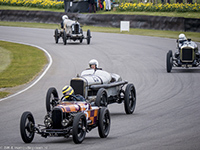74th Members' Meeting report
Edwardians to the fore in crash-marred event
Author & photography
- Mattijs Diepraam
Date
- March 23, 2016
Related articles
- Goodwood - No crowding proves a delight for the right crowd, 72nd GRRC Members' Meeting report, by Mattijs Diepraam
- Goodwood - Still the right crowd, but slightly more crowding, 73rd GRRC Members' Meeting report, by Mattijs Diepraam
- Goodwood - Through the ice and snow, 76th GRRC Members' Meeting report, by Mattijs Diepraam
- Goodwood - Spring fever, 77th GRRC Members' Meeting report, by Mattijs Diepraam
- Goodwood - Getting back into the groove, 80th GRRC Members' Meeting report, by Mattijs Diepraam
Why?
On a messy race day that saw several races punctuated by safety car periods, the Edwardians making their Goodwood debut proved to be the stars of the show. Not only did all cars bar two make it to the finish in one piece, the Selwyn Edge Trophy also entertained the crowd with a magnificent lead battle that in terms of excitement was left unchallenged by any of the other races. It was as if a 100 years of technological innovation hadn’t made any difference. Sadly though, the Sunday was marred by several nasty accidents that left a couple of drivers in the wars. Fortunately, their injuries were relatively minor compared to the huge impact they suffered.
And so it happened that the oldest cars of the weekend grabbed the hearts and minds of the 30,000-strong crowd. It was perhaps fitting that Duncan Pittaway, who had driven his little Curtiss aero-engined GN all the way down to Goodwood, drove home with the trophy – literally – after fending off the Delage DH V12 of Argentinian Mathias Sielecki and Julian Majzub’s Sunbeam Indianapolis. What’s more, the fire-breathing (and bellowing) monsters from an era of smoke and steel delivered more speed than many had expected them to show.
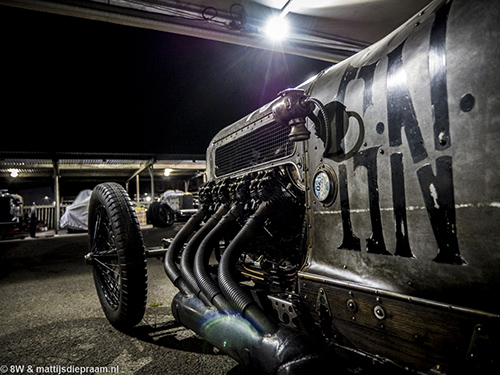
The Edwardians looked even better at night. (photo 8W)
It turned the Selwyn Edge Trophy into the undoubted highlight of a two-faced meeting. On Saturday, proceedings were smooth beyond belief, with not a minute of delay. On Sunday, the timetable was a mess from the first lap of the day. After three huge crashes, numerous safety car periods and races lengthened to give the drivers a green-flag sprint to the finish, the final three races had to be shortened considerably to make the 18:30 curfew.
Stephen Bond’s accident in the Brooks Trophy for 2.5-litre F1 cars from 1954 to 1960 will be hard to repeat, such was its enormity. It was a shocking start to the Sunday, and left anyone who had been a witness wide-eyed for the remainder of the day. The catalyst was Richard Wilson spinning his Cooper T51 out of the chicane to slam straight into the side of Bond’s Lotus 18. This flipped the Lotus into a series of barrel rolls before hitting the straw bale that was intended to safeguard the entry to the paddock crossing. Now, however, its function proved disastrous as it catapulted the hapless Lotus into a mortifying concatenation of nose-to-tail-to-nose flips before it disappeared out of sight, having plunged straight into the pedestrian tunnel for club members.
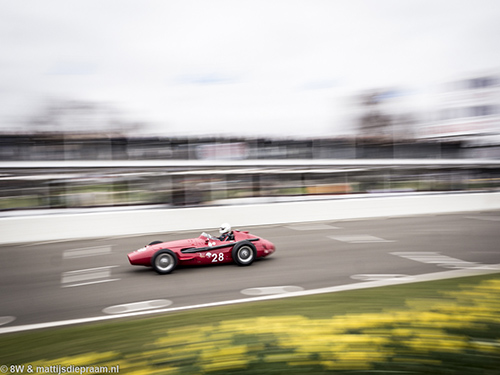
Graham Adelman charging his Maserati 250F across the start-and-finish straight. (photo 8W)
Bond must have carried a legion of guardian angels on his shoulders since apart from breaking his collar bone, he was left without a scratch. His luck had been that the Lotus ended up on the railing placed there to separate the two flows of pedestrian traffic, which at that moment acted as some sort of external roll hoop, preventing Bond’s neck from absorbing the impact. Goodwood itself was lucky too, that no-one was using the tunnel at that time. Moreover, the viewing area for the disabled is located right next to the tunnel, hosting a vulnerable group of spectators that cannot run for their lives. We can only hope that the investigation into the track’s safety – announced on the Monday after – will lead to alterations that will make the historic circuit safer without taking away from its unique character.
Due to a lengthy safety car period, the Derek Bell Cup for late-sixties and early-seventies F3 screamers won by Andrew Hibberd in a Brabham BT6 saw further delay added to the timetable. So when the early sixties GTs got on track after the Edwardians had treated the crowd to a much-needed clean race the programme was running an hour late. Sadly, we saw even more of the safety car when the Graham Hill Trophy got underway.
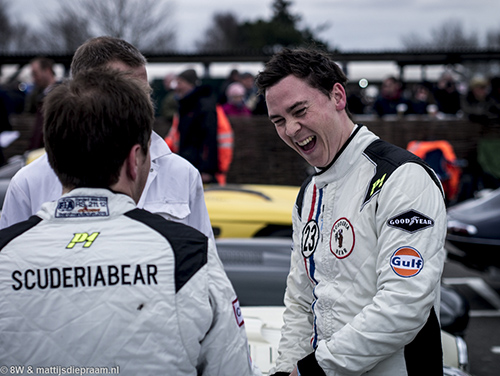
James Cottingham is pretty pleased with his pole position for the Graham Hill Trophy, as he shares the fun with team mate and fellow Shelby Cobra Daytona Coupé Andrew Smith. (photo 8W)
The Shelby Cobra Daytona Coupés of James Cottingham and Andrew Smith ran away with a 1-2 but that was after a huge smash by Karsten Le Blanc at Fordwater when his throttle stuck open. It was a huge relief when we saw him walking into the paddock under his own power, with just a dent in his pride and a couple of bruised ribs, that according to the track doctor would go on to hurt for the next few weeks. Still, it could have been a lot worse.
More pictures of the Saturday paddock atmosphere and track action
The seventies touring cars were next in the battle to win the ever popular Gerry Marshall Trophy. Chris Ward had taken the sprint race on Saturday in his JD Classic Rover 3500 SD1 but the big race on Sunday (with compulsory driver change, but shortened to 40 minutes) Ward and his team mate Gordon Shedden had to bow to the Camaro of father-and-son team Graeme and Oliver Bryant.
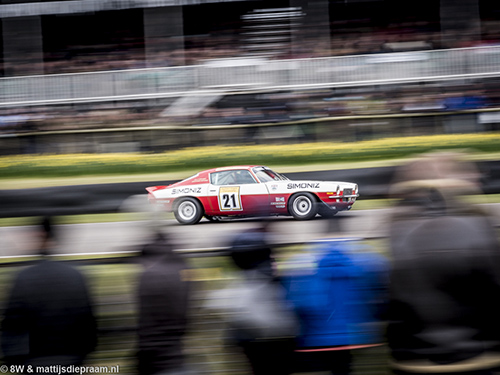
The Bryant/Bryant Camaro took the Gerry Marshall Trophy spoils. (photo 8W)
Then, to put a further damper on everyone's spirits, the Bruce McLaren Trophy featuring CanAm and Group 7 cars up to 1966 was redflagged after just two laps. Approaching Woodcote with locked brakes, apparently taking avoiding action because of flying debris coming towards him, Michiel Smits went straight on to hit the barriers full on, bending his newly acquired ex-Donohue Lola T70 ‘Zerex Special’ almost beyond recognition. After what seemed like an eternity the Dutchman was seen standing besides the wreckage, supported by two of the rescue crew and holding his shoulder in pain.
Airlifted to Brighton hospital, Smits was diagnosed with a couple of broken ribs and two fractured vertebrae. Fortunately, there was no spinal injury which means that Smits will in time make a full recovery. The experienced Dutch GT racer made his Goodwood debut and will have dreamt of an entirely different scenario. Nick Padmore, who had lowered the qualifying lap record to 1.17.0 the previous day, was declared the winner.
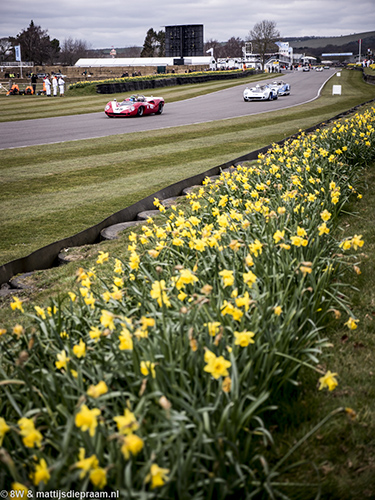
The Bruce McLaren Trophy was redflagged after two laps following a huge accident that involved Michiel Smits' Lola T70. Nick Padmore was declared the winner. (photo 8W)
The three remaining races had to be shortened to make the curfew. In his Cooper-Bristol Mk2, Will Nuthall easily won the Parnell Cup for pre-53 F1 and F2 cars, leading home the Cooper Mk1 of Eddie McGuire and Belgian Marc Valvekens in his Gordini T16. The Whitmore Cup for sixties touring cars was alotted a mere ten minutes. During the ten-minute dash Cortinas swept the board, Richard Meaden taking the spoils ahead of Mark Sumpter and John Young. In the weekend-closing Peter Collins Trophy for fifties sportscars, Sam Hancock proved almighty in his Cunningham C4R, storming away to a 26-second victory over Steve Boultbee Brooks (Aston Martin DB3S) and Richard Woolmer (HWM-Cadillac).
On Saturday, the day ended with the Alan Mann Trophy, a race for Ford’s GT40 exclusively. Ten cars failed to make it to the finish, with several of the early leaders among them. This handed victory to the David Cuff/Steve Soper car, ahead of Wood/Stretton and Folch/Hadfield.
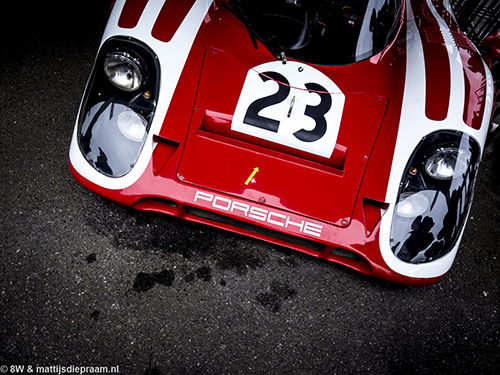
The Salzburg Porsche 917 was one of nine 917s present. (photo 8W)
Just like last year, the Members’ Meeting demos were brilliant again. To some the Group 5 demo showcasing numerous Porsche 917s, Ferrari 512s and Lola T70 Mk3Bs was the true highlight of the event, while the ground-effect F1 cars gave new meaning to the term ‘high-speed demo’. Drivers such as Bobby Verdon-Roe, Loïc Deman and Andy Wolfe really put the hammer down, resulting in regular sub-1.10 laps. The Super Touring machines of the nineties succumbed to timetable pressures on Sunday, having only been given one flying lap, but it was great to see them blast around Goodwood nonetheless. The W196 cars with which Mercedes dominated Formula 1 in the mid-fifties were the final unique element to a demo line-up that gave lots of value for money. After the demos during the first Members’ Meeting of the modern era proved to be slightly disappointing, the Goodwood team have learned very quickly.
More pictures of the Sunday paddock atmosphere and track action
In a previous version of this report the driver of the No.15 Cooper T51 involved in Stephen Bond's accident was mistakenly identified as Malcolm Cook (who drove the No.14 Cooper T43). He had no part in the incident, and we apologize for our error.

